Audi Urban Future Initiative 2012

Audi kicked off its Urban Future Initiative in 2010, with an exhibition and awards ceremony at the Venice Architecture Biennale. The firms that took part included Alison Brooks Architects from London, BIG from Copenhagen, Cloud 9 from Barcelona and Standard Architecture from Beijing, with the winning proposal coming from German digital wunderkind Jürgen Mayer.
Fast-forward two years, and the initiative is in full flow, with a second awards recently taking place in Istanbul as part of the city's first Design Biennial. Taking over a sizeable chunk of the former Hasköy Wool Yarn Factory, now a major event space on the banks of the Golden Horn, the AUFI saw invited participants tasked with bringing a clean slate approach to the problems of urban mobility. The event and competition was overseen by the Frankfurt-based agency Stylepark.
It's not surprising that a car company would want to streamline the process of urban driving. Back in the 1960s, this subject was the preserve of architects and planners; car makers kept their noses out, mostly safe in the knowledge that the status quo was on their side. Five decades later and we're more congested than ever (Istanbul being an especially good place to prove the point), a bottleneck that threatens health, wealth and - most pressingly of all for the likes of Audi - future sales.
Enter the architects. The five teams were drawn from around the world, including China's NODE Architecture, São Paulo's Urban-Think Tank, Mumbai's CRIT, America's Höweler + Yoon Architecture and local studio Superpool. Each set out their vision for tomorrow's urban mobility, arranged as a series of translucent pavilions.
The inter-disciplinary nature of many of this year's studios showed a far greater concern for specific research, not big picture daydreaming. Not all the schemes were totally sympathetic to a future where the car was still king. Audi makes no bones about this being a research exercise, something that'll feed ideas and concepts back into the design of their cars. Indeed, the firm has showed several small-scale city car concepts in recent years, and is also making great strides towards a world of autonomous driving, especially in the nose-to-tail environment of the traffic jam.
In the end, the jury, which included Audi's CEO Rupert Stadler - who has made the AUFI into something of a pet project - respected design theorist John Thackara together with Mayer, selected a re-working of the American dream by the young Boston-based studio of Höweler + Yoon. Of all the proposals, H+Y's perhaps saw the bluest of skies, focused as it was on big picture infrastructural shifts to transform the eastern seaboard into a place of perpetual motion. The studio won 100,000 euros and the chance to work up their scheme into a detailed dossier, complete with original research.
See the winning scheme and the runner-up proposals in our gallery. More information can be found at Mooove.com, Audi's new dedicated mobility portal.

Höweler + Yoon suggest that infilling the area between highways and highspeed rail will create new building types and new opportunities for urban agriculture
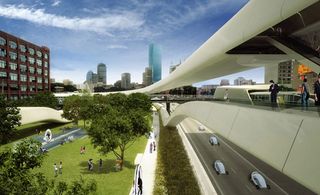
The 'Shareway' is Höweler + Yoon's vision of a superhighway complex, delivering fast traffic long distances, with integrated high speed rail and small scale electric car sharing

Höweler + Yoon imagine a future where you can step off an intercity train and straight into a 'last mile car' - powered by the kinetic energy released by the braking train - to take you home

CRIT's 'Being Nicely Messy' concept taps into the adhoc expansion of Mumbai, with its web of manufacturing, entrepreneurship and chaotic transport systems, to propose new typologies, associations and even professions, rebuilding the way the city works from the ground up
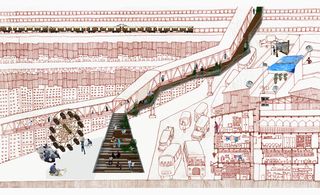
Mumbai's multi-layered future society is revealed in CRIT's concept for a city of new options and opportunities

A model of NODE's proposal; a vast subterranean complex of automated delivery tunnels, freeing up the streets of Shenzhen for personal transit, not goods and services

NODE envision an underground world of delivery systems, constantly whirring beneath our feet

Superpool's installation looks at the role of car-sharing in the congested city - in this case their home town of Istanbul

Through a combination of smartphone apps and community collaboration, Superpool propose a city of reclaimed streets
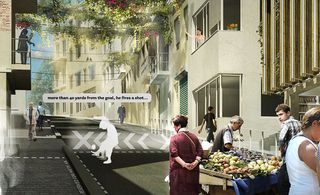
Superpool's vision of an Istanbul with minimal auto involvement
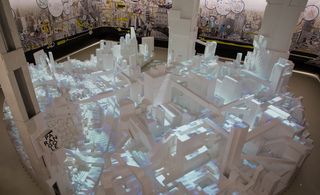
Urban-Think Tank's installation is dominated by this large-scale model of future São Paulo
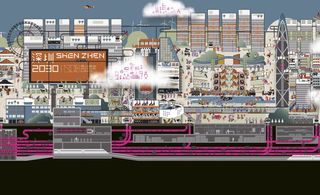
Urban-Think Tank have worked extensively with São Paolo's various stakeholders, from the mayor's office onwards. Their Skywalk proposal simply suggests building up, not out, capitalising on the city's air rights to build new interconnected communities in the sky
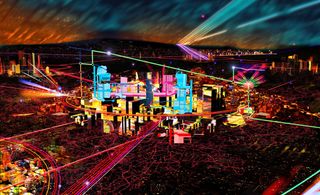
The multi-layered city of the future, as set out in Urban-Think Tank's 'Urban Parangole'
Wallpaper* Newsletter
Receive our daily digest of inspiration, escapism and design stories from around the world direct to your inbox
Jonathan Bell has written for Wallpaper* magazine since 1999, covering everything from architecture and transport design to books, tech and graphic design. He is now the magazine’s Transport and Technology Editor. Jonathan has written and edited 15 books, including Concept Car Design, 21st Century House, and The New Modern House. He is also the host of Wallpaper’s first podcast.
-
 Inside Valentino’s glamorous new Sloane Street store, inspired by the art of haute couture
Inside Valentino’s glamorous new Sloane Street store, inspired by the art of haute coutureThe latest in Valentino’s ‘The New Maison’ store concept opens on London’s Sloane Street this week, offering an enveloping marble and carpet-clad space of ‘intimacy and uniqueness’
By Jack Moss Published
-
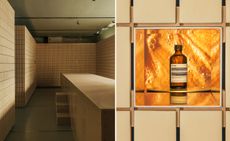 Aesop’s Salone del Mobile 2024 installations in Milan are multisensory experiences
Aesop’s Salone del Mobile 2024 installations in Milan are multisensory experiencesAesop has partnered with Salone del Mobile to launch a series of installations across Milan, tapping into sight, touch, taste, and scent
By Hannah Tindle Published
-
 Dial into the Boring Phone and more smartphone alternatives
Dial into the Boring Phone and more smartphone alternativesFrom the deliberately dull new Boring Phone to Honor’s latest hook-up with Porsche, a host of new devices that do the phone thing slightly differently
By Jonathan Bell Published
-
 Farewell to the Audi TT, a design icon that evolved with the automotive landscape
Farewell to the Audi TT, a design icon that evolved with the automotive landscapeFor over 25 years, the Audi TT has been synonymous with the brand, a modern machine that initially favoured style over sport. The final editions are very different beasts to the original
By Jonathan Bell Published
-
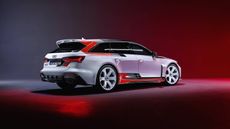 Audi RS6 Avant GT is an estate car that thinks it belongs on the track
Audi RS6 Avant GT is an estate car that thinks it belongs on the trackWith the Audi RS6 Avant GT limited-edition supercar, Audi Sport has gone all-out to create the ultimate hyper-estate
By Jonathan Bell Published
-
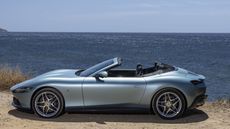 Year in review: the top 10 cars of 2023, as selected by Wallpaper’s Jonathan Bell
Year in review: the top 10 cars of 2023, as selected by Wallpaper’s Jonathan BellWhat were the best four-wheeled offerings of 2023? Transport editor Jonathan Bell takes us through the year’s most intriguing automobiles
By Jonathan Bell Published
-
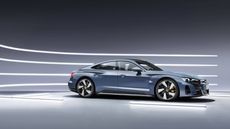 Audi e-tron GT quattro still pushes all the right buttons. But what happens next?
Audi e-tron GT quattro still pushes all the right buttons. But what happens next?Life behind the wheel of Audi’s elegant electric GT, plus a short history of the company’s e-tron series, from concept through to production
By Jonathan Bell Published
-
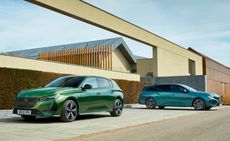 Peugeot’s sparky 308 gets hybrid power and handsome lines
Peugeot’s sparky 308 gets hybrid power and handsome linesThe Peugeot 308 proves that mass-market design needn’t be dull, blending hybrid power with sharp lines and excellent detailing
By Jonathan Bell Published
-
 BMW Motorrad brings out the big guns for its newest cruisers
BMW Motorrad brings out the big guns for its newest cruisersBMW Motorrad R 18 Bagger and Transcontinental set the tone for high-voltage cruising with a brand collaboration with speaker specialist Marshall
By George Chapman Last updated
-
 Dacia’s new Manifesto concept is a true outdoor utility vehicle
Dacia’s new Manifesto concept is a true outdoor utility vehicleUtilitarian auto brand Dacia sets a bold new agenda with its Manifesto, a concept car pitched at the active outdoor market
By Jonathan Bell Last updated
-
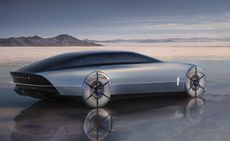 The sun sets on traditional supercars at California’s Monterey Car Week
The sun sets on traditional supercars at California’s Monterey Car WeekMonterey Car Week, the world’s most prestigious car gathering, is showcasing ever-more extravagant special editions, coachbuilt cars and all-new electric concepts. Here are seven key machines from 2022
By Rory FH Smith Last updated